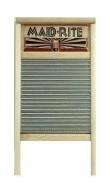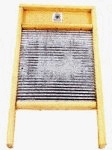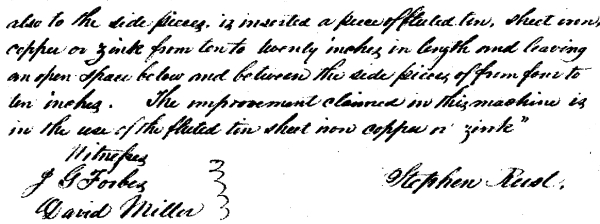-
History of:
- Resources about:
- More:
- Baby walkers
- Bakehouses
- Bed warmers
- Beer, ale mullers
- Besoms, broom-making
- Box, cabinet, and press beds
- Butter crocks, coolers
- Candle snuffers, tallow
- Clothes horses, airers
- Cooking on a peat fire
- Drying grounds
- Enamel cookware
- Fireplaces
- Irons for frills & ruffles
- Knitting sheaths, belts
- Laundry starch
- Log cabin beds
- Lye and chamber-lye
- Mangles
- Marseilles quilts
- Medieval beds
- Rag rugs
- Rushlights, dips & nips
- Straw mattresses
- Sugar cutters - nips & tongs
- Tablecloths
- Tinderboxes
- Washing bats and beetles
- Washing dollies
- List of all articles
Subscribe to RSS feed or get email updates.
Washing bats... hardwood... cross-ribbed, on one face, so that they could also act as rubbing boards...
E. H. Pinto, Treen and other Wooden Bygones, 1969
"Family size" washboard from Amazon
Plain galvanized washboard from Amazon
A wooden washboard probably injures the clothes as little as any kind, but is rather unpleasant to use unless one is accustomed to it. Wooden washboards may split in time, if not well cared for. In selecting a glass or metal-covered board, choose one that is not too much corrugated, because many angles wear the clothes as they glide over them.
Juniata Shepherd, Laundry work for use in homes and schools, 1909
Two wash-forms are needed; one for the two tubs in which to put the suds, and the other for blueing and starching-tubs. Four tubs, of different sizes, are necessary; also, a large wooden dipper, (as metal is apt to rust;) two or three pails; a grooved wash-board; a clothes-line, (sea-grass, or horse-hair is best;) a wash-stick to move clothes, when boiling, and a wooden fork to take them out. Soap-dishes, made to hook on the tubs, save soap and time. Provide, also, a clothes-bag, in which to boil clothes; an indigo-bag, of double flannel; a starch-strainer, of coarse linen; a bottle of ox-gall for calicoes; a supply of starch, neither sour nor musty; several dozens of clothes-pins, which are cleft sticks, used to fasten clothes on the line; a bottle of dissolved gum Arabic; two clothes-baskets; and a brass or copper kettle, for boiling clothes, as iron is apt to rust.
Catherine Beecher, A Treatise on Domestic Economy, 1843
When were washboards invented?
Washing and scrubbing boards
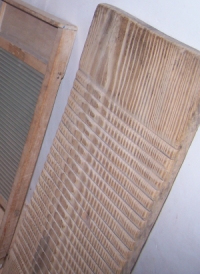 In 1868 the New York Times
called washboards "a great American invention" and ran a story about a man taking
"a wooden grooved washboard" home to his sister in Germany as a novelty. Yet "it
is believed that ribbed wooden scrubbing boards originated in Scandinavia and the
manufacture spread to other countries during the 19th century," said
Edward Pinto, an expert on domestic objects crafted from wood.
In 1868 the New York Times
called washboards "a great American invention" and ran a story about a man taking
"a wooden grooved washboard" home to his sister in Germany as a novelty. Yet "it
is believed that ribbed wooden scrubbing boards originated in Scandinavia and the
manufacture spread to other countries during the 19th century," said
Edward Pinto, an expert on domestic objects crafted from wood.
So when were washboards invented? There isn't going to be a neat and tidy answer to this - how can we guess when someone first cut notches into a piece of wood used for scrubbing clothes? - but we can tease out a few facts. First, here are links to a couple of 19th century Scandinavian washboards of the kind with a long heritage: one from Norway, one from Finland.
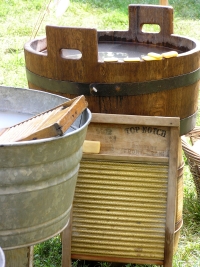 In Northern England there was a tradition of
washing bats with ridged surfaces, though many were smooth. Except for their
handles, allowing them to be used as beaters, they were pretty much like washboards.
And many of the decoratively carved washing bats found across Scandinavia, the Baltic
countries, and other parts of Europe had enough texture on the surface to rival
grooved washboards. Boards were used by washerwomen in
Italy well before the 19th century, and tilted boards on legs called washing
stocks were used in England, France and elsewhere,
but these had no grooves.
In Northern England there was a tradition of
washing bats with ridged surfaces, though many were smooth. Except for their
handles, allowing them to be used as beaters, they were pretty much like washboards.
And many of the decoratively carved washing bats found across Scandinavia, the Baltic
countries, and other parts of Europe had enough texture on the surface to rival
grooved washboards. Boards were used by washerwomen in
Italy well before the 19th century, and tilted boards on legs called washing
stocks were used in England, France and elsewhere,
but these had no grooves.
Some google searches suggest that the washboard was invented in 1797, but this cannot be right. 1797 is the date of a lost US patent offering an "improvement" in washing clothes, but this was certainly not the only attempt to invent better ways of doing laundry around that time. There were even some 18th century washing machines in England and Germany.
At the turn of the 19th century washboards were not yet standard household equipment
in the US. Specialist opinion at
Mount Vernon (Virginia) says there's no evidence they were in use in that
area. Meanwhile inventors were starting to experiment with "machines" including
grooved boards, grooved tubs, and more, as they tried to lighten heavy laundry work.
Were they inspired by mama's old wooden board or bat?
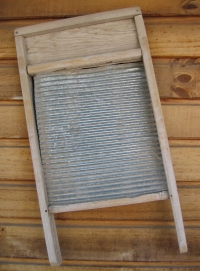
Zinc and other innovations
Metal washboards were surely a "great American invention".
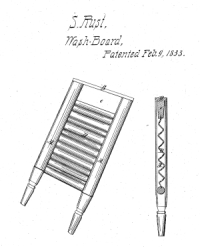 1833 offers a good clear-cut
date in their story. On February 9th 1833, Stephen Rust of Manlius, NY patented
a new idea: a "Wash Board" with a piece of "fluted tin, sheet iron, copper or zink".
(We were pleased to find this at the
US Patent Office. It appears to be the first patent for a metal washboard.)
1833 offers a good clear-cut
date in their story. On February 9th 1833, Stephen Rust of Manlius, NY patented
a new idea: a "Wash Board" with a piece of "fluted tin, sheet iron, copper or zink".
(We were pleased to find this at the
US Patent Office. It appears to be the first patent for a metal washboard.)
In 1842 a wooden washboard coated in rubber was patented by Marcellus Sands of Franklin, NY.
In 1843 Catherine Beecher said a "grooved wash-board" was amongst the "articles to be provided for washing" in households planning "a full supply of all conveniences". (See left-hand column.)
By 1845 there was a listing in a Chicago business directory for a manufacturer of "the improved zinc wash-boards". How much, if at all, Mr. Rust (inappropriate name?) benefited is unclear.
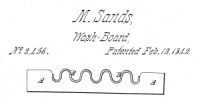 Glass washboards
must have arrived before 1877, when Hermann Liebmann of Chicago patented an "improvement
in wash-boards" with his idea of perforating "glass or porcelain or terracotta".
Glass washboards
must have arrived before 1877, when Hermann Liebmann of Chicago patented an "improvement
in wash-boards" with his idea of perforating "glass or porcelain or terracotta".
Questions - in search of a "timeline"
This article took shape after an email exchange with the writer Kate Dolan who has a special interest in 18th century Maryland. There seems to be no evidence that the wooden washboard was a standard domestic item in 18th century North America. But what were things like between 1800 and the 1830s?
...dear Franklin has made me a nice pr of bedsteads, 2 washboards...
Letter written by Anna Briggs Bentley, a Quaker, in 1837 - from American Grit: A Woman's Letters from the Ohio Frontier, ed. Emily Foster, 2003
Did washboards spread out from particular communities - from Scandinavian settlers, or from Quakers, perhaps? Please consider emailing if you have answers.
The 1833 washboard patent
Be it known that I Stephen Rust of the Town of Manlius in the County of Onondaga and State of New York have invented a new and useful improvement in making "Wash Boards" and that the following is a full and exact description of the construction of said machine as invented or improved by me viz. "The side pieces of the frame are made of wood from one inch to three inches wide, and from twenty to thirty inches long and set from six to sixteen inches apart and parallel to each other. Between and attached to the side pieces in the upper part of the frame is inserted a plain board from one to six inches in width and slightly curved downwards. Attached to the board and also to the side pieces is inserted a piece of fluted tin, sheet iron, copper or zink [zinc] from ten to twenty inches in length and leaving an open space below and between the side pieces of from four to ten inches. The improvement claimed in this machine is in the use of the fluted tin sheet iron copper or zink.
Note that the washboard is called a "machine". This seems odd, even though dictionary (OED) definitions include "an apparatus, device, instrument, or implement". Perhaps this particular usage was Patent Office jargon?
More on washing with boards:
French washboards at the riverside
Washing boards in Italy
For more on laundry history and old washing methods go to
>>>> History of laundry and
>>>> Laundry from 1800
Or you may like:
Washing bats
Washing dollies
Bleaching with ashes (lye)
Laundry blue
And also:
History of ironing
To wash corsets: Take out the steel; use hot water; one teaspoonful of borax to every pail of water; place the corsets on the washboard and scrub well with a clean brush, using very little soap; do not boil the corsets, but if very yellow bleach in the sun; rinse well; rub in a little starch; iron when quite damp.
Hawera & Normanby Star, New Zealand, 1880
 26 September 2007
26 September 2007
You may like our new sister site Home Things Past where you'll find articles about antiques, vintage kitchen stuff, crafts, and other things to do with home life in the past. There's space for comments and discussion too. Please do take a look and add your thoughts. (Comments don't appear instantly.)
For sources please refer to the books page, and/or the excerpts quoted on the pages of this website, and note that many links lead to museum sites. Feel free to ask if you're looking for a specific reference - feedback is always welcome anyway. Unfortunately, it's not possible to help you with queries about prices or valuation.


